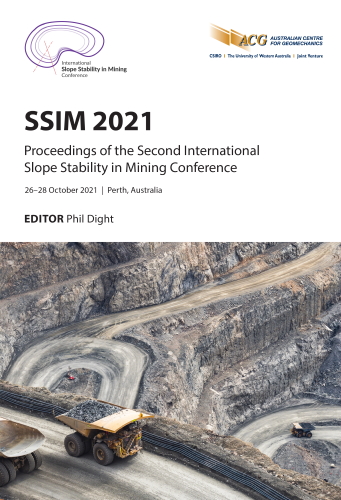Ground support in open pits and operational safety

|
Authors: Welideniya, S; Bar, N; Price, J |
DOI https://doi.org/10.36487/ACG_repo/2135_18
Cite As:
Welideniya, S, Bar, N & Price, J 2021, 'Ground support in open pits and operational safety', in PM Dight (ed.), SSIM 2021: Second International Slope Stability in Mining, Australian Centre for Geomechanics, Perth, pp. 287-294, https://doi.org/10.36487/ACG_repo/2135_18
Abstract:
Slope stability and operational safety are important aspects of open pit mining operations which are susceptible to geotechnical hazards including rockfall planar, wedge and toppling failures, as well as largescale slope failures. Very well planned pit designs alone cannot fully eliminate all risks (in terms of likelihood and consequence) to personnel from these geotechnical hazards as site investigations are often limited. Some manageable low risk instability is acceptable in the context of mining economics. Slope monitoring systems such as survey prisms, radar and laser scanning are used to monitor slope movements to assist in mine safety. Administrative or procedural control measures such as trigger action response plans (TARPs) and ground awareness training (GAT) are often also used to manage risks. Ground support regimes can further mitigate risks either by means of stabilisation or as a safety control where required, and include shear pins, cable bolts, rockbolts, drape mesh and catch fences. This paper provides insight into the selection of ground support in various ground conditions and their impact on operational safety.
Keywords: active ground support, passive ground support, normal stress, asperities, kinematic stability, cable bolts, drape mesh
References:
Baczynski, N & Bar, N 2017, ‘Landslide monitoring and management challenge in remote Papua New Guinea’, in M Mikoš, N Casagli, Y Yin & K Sassa (eds), Fourth World Landslide Forum: Advancing Culture of Living With Landslides, Springer, Cham, , pp. 343–354.
Bar, N, Parker, R & Thomas, S 2016, ‘Managing landslide risks associated with erosion-driven slope instabilities using near real-time deformation monitoring systems’, in R Ulusay, O Aydan, H Gercek, MA Hindistan & E Tuncay (eds), Rock Mechanics and Rock Engineering: From the Past to the Future, Proceedings of the ISRM International Symposium – EUROCK 2016, CRC Press, Boca Raton, pp. 1191–1196.
Bar, N, Weekes, G & Welideniya, S 2018, ‘Benefits and limitations of applying directional shear strengths in 2D and 3D limit equilibrium models to predict slope stability in highly anisotropic rock masses’, in V Litvinenko (ed.), Geomechanics and Geodynamics of Rock Masses, ISRM International Symposium – EUROCK 2018, CRC Press, Boca Raton, pp. 761–766.
Coates, R, Bull, G, Glisson, F & Roth, A (2004), ‘Highly flexible catch fences and high performance drape mesh systems for rock fall protection in open pit operations’, in E Villaescusa & Y Potvin (eds), Ground Support in Mining and Underground Construction: Proceedings of the Fifth International Symposium on Ground Support, Perth, Western Australia, pp. 472–488.
Department of Mines, Industry Regulation and Safety 2019, Ground Control Management in Western Australian Mining Operations, Department of Mines, Industry Regulation and Safety, Perth,
MSH_GL_GroundControl.pdf
Government of Western Australia 1994, Mines Safety and Inspection Act 1994, Australia.
Government of Western Australia 1995, Mines Safety and Inspection Regulations 1995, Australia.
Indraratna, B, Welideniya, S & Brown, T 2005, ‘A shear strength model for idealised infilled joints under constant normal stiffness (CNS)’, Géotechnique, vol. 55, no. 3, pp. 215–226.
Patton, F 1966, ‘Multiple modes of shear failure in rocks’, Proceedings of the First ISRM Congress – CONGRESS66, pp. 509–513.
Saroglou, H & Bar, N 2017, ‘Predicting the primary impact and total rollout distances of rockfalls based on cases in quarries and mines in Australia and the United Kingdom’, Proceedings of the ARMA 51st US Rock Mechanics / Geomechanics Symposium, American Rock Mechanics Association, Alexandria.
Siedel, JP & Haberfield, CM 1995, ‘Towards an understanding of joint roughness’, Rock Mechanics and Rock Engineering, vol. 28, no. 2, pp. 69–92.
Welideniya, S 2016, ‘Robust approach for life saving mine designs and slope monitoring – practical approach to produce high recovery best designs with lifesaving safety practices’, International Mining Myanmar Conference.
© Copyright 2024, Australian Centre for Geomechanics (ACG), The University of Western Australia. All rights reserved.
View copyright/legal information
Please direct any queries or error reports to repository-acg@uwa.edu.au
View copyright/legal information
Please direct any queries or error reports to repository-acg@uwa.edu.au